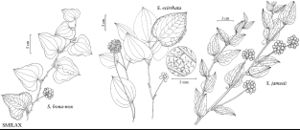Difference between revisions of "Smilax jamesii"
Brittonia 31: 416, fig. 1. 1979.
FNA>Volume Importer |
FNA>Volume Importer |
||
| Line 36: | Line 36: | ||
-->{{#Taxon: | -->{{#Taxon: | ||
name=Smilax jamesii | name=Smilax jamesii | ||
| − | |||
|authority=G. A. Wallace | |authority=G. A. Wallace | ||
|rank=species | |rank=species | ||
| Line 51: | Line 50: | ||
|publication year=1979 | |publication year=1979 | ||
|special status= | |special status= | ||
| − | |source xml=https://jpend@bitbucket.org/aafc-mbb/fna-data-curation.git/src/ | + | |source xml=https://jpend@bitbucket.org/aafc-mbb/fna-data-curation.git/src/f50eec43f223ca0e34566be0b046453a0960e173/coarse_grained_fna_xml/V26/V26_990.xml |
|genus=Smilax | |genus=Smilax | ||
|species=Smilax jamesii | |species=Smilax jamesii | ||
Revision as of 21:54, 16 December 2019
Herbs; rhizomes brown or black, zigzag. Stems annual, climbing, branched, 2–3 m, herbaceous, glabrous; prickles absent. Leaves evenly distributed, proximalmost reduced to bracts; petiole shorter than blade; tendrils numerous, long, functional; blade dark green, triangular, ovate, or slightly hastate, 2.5–8.5 × 4–7.5 cm, membranous, glabrous and glaucous abaxially, base truncate, cordate, or hastate, lobes rounded; margins entire; apex cuspidate. Umbels axillary to leaves, staminate to 20-flowered, pistillate few–40-flowered, moderately dense, subspherical; peduncle of staminate umbel ± equaling subtending leaf, pistillate to 13.5 cm. Flowers: perianth light green; tepals 1.5–2 mm; anthers slightly shorter than to equaling filaments; ovules (1–)2 per locule; pedicel thin, ca. 1.5 cm. Berries blue, ovoid, 6–8 mm.
Phenology: Flowering May–Jul.
Habitat: Alder thickets, lake and stream sides, bracken fern slopes
Elevation: 1200–2500 m
Discussion
Of conservation concern.
Smilax jamesii is the only herbaceous species of Smilax known to occur in western North America. It is found in the Klamath Mountains.

